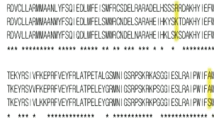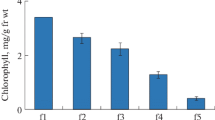Abstract
The enzyme 5-enolpyruvylshikimate-3-phosphate (EPSP) synthase (EC 2.5.1.19), the target of the herbicide glyphosate [N-(phosphonomethyl)glycine], exists in two molecular forms in Euglena gracilis. One form has previously been characterized as a monofunctional 59 kDa protein. The other form constitutes a single domain of the multifunctional 165 kDa arom protein. The two enzyme forms are inversely regulated at the protein and mRNA levels during light-induced chloroplast development, as demonstrated by the determination of their enzyme activities after non-denaturing polyacrylamide gel electrophoresis and Northern hybridization analysis with a Saccharomyces cerevisiae ARO1 gene probe. The arom protein and its mRNA predominate in dark-grown cells, and the levels of both decline upon illumination. In contrast, the monofunctional EPSP synthase and its mRNA are induced by light, the increase in mRNA abundance preceding accumulation of the protein. The two enzymes are localized in different subcellular compartments, as demonstrated by comparing total protein patterns with those of isolated organelles. Glyphosate-adapted wild-type cells and glyphosate-tolerant cells of a plastid-free mutant of E. gracilis, W10BSmL, were used for organelle isolation and protein extraction, as these cell lines overproduce EPSP synthase and the arom protein, respectively. Evidence was obtained for the cytosolic localization of the arom protein and the plastid compartmentalization of the monofunctional EPSP synthase. These conclusions are further supported by the observation that EPSP synthase precursor, produced by in vitro translation of the hybrid-selected mRNA, was efficiently taken up and processed to mature size by isolated chloroplasts from photoautotrophic wild-type E. gracilis cells, while the in vitro-synthesized arom protein was not sequestered by isolated Euglena plastids.
Similar content being viewed by others
References
Berlyn MB, Ahmed SI, Giles NH (1970) Organization of polyaromatic biosynthetic enzymes in a variety of photosynthetic organisms. J Bacteriol 104:768–774
Burgoyne L, Case ME, Giles NH (1969) Purification and properties of the aromatic (arom) synthetic enzyme aggregate of Neurospora crassa. Biochim Biophys Acta 191:452–462
Byng GS, Whitaker RJ, Jensen RA (1985) Glyphosate as a probe of the pentafunctional arom protein of Euglena gracilis. Can J Bot 63:1021–1024
Chan RL, Keller M, Canaday J, Weil J-H, Imbault P (1990) Eight small subunits of Euglena ribulose-1,5-bisphosphate carboxylase/oxygenase are translated from a large mRNA as a polyprotein. EMBO J 9:333–338
Chang J-Y (1983) Manual micro-sequence analysis of polypeptides using dimethylaminoazobenzene isothiocyanante. Methods Enzymol 91:455–466
Chang J-Y, Brauer D, Wittmann-Liebold B (1978) Microsequence analysis of peptides and proteins using 4-N,N-dimethylaminobenzene 4'isothiocyanate/phenylisothiocyanate double coupling method. FEBS Lett 93:205–214
Charles IG, Keyte JW, Brammer WJ, Smith M, Hawkins AR (1986) The isolation and nucleotide sequence of the complex AROM locus of Aspergillus nidulans. Nucleic Acids Res 14:2201–2213
Cline K, Werner-Washburne M, Andrews J, Keegstra K (1984) Thermolysin is a suitable protease for probing the surface of intact pea chloroplasts. Plant Physiol 75:675–678
Cramer M, Myers J (1952) Growth and photosynthetic characteristics of Euglena gracilis. Arch Mikrobiol 17:384–402
della-Cioppa G, Kishore GM (1988) Import of a precursor protein into chloroplasts is inhibited by the herbicide glyphosate. EMBO J 7:1299–1305
della-Cioppa G, Bauer SC, Klein BK, Shah DM, Fraley RT, Kishore GM (1986) Translocation of the precursor of 5-enolpyruvylshikimate-3-phosphate synthase into chloroplasts of higher plants in vitro. Proc Natl Acad Sci USA 83:6873–6877
Duncan K, Lewendon A, Coggins JR (1984) The complete amino acid sequence of Escherichia coli 5-enolpyruvylshikimate-3-phosphate synthase. FEBS Lett 170:59–63
Duncan K, Edwards RM, Coggins JR (1987) The pentafunctional arom enzyme of Saccharomyces cerevisiae is a mosaic of monofunctional domains. Biochem J 246:375–386
Gaertner FH, Cole KW (1977) A cluster gene: Evidence for one gene, one polypeptide, five enzymes. Biochem Biophys Res Commun 75:259–264
Gasser CS, Klee HJ (1990) A Brassica napus gene encoding 5-enolpyruvylshikimate-3-phosphate synthase. Nucleic Acids Res 18:2821
Gasser CS, Winter JA, Hironaka CM, Shah DM (1988) Structure, expression, and evolution of the 5-enol-pyruvylshikimate-3-phosphate synthase genes of petunia and tomato. J Biol Chem 263:4280–4287
Haslam E (1974) The shikimate pathway. Butterworths, London
Holländer-Czytko H, Amrhein N (1987) 5-Enolpyruvylshikimate-3-phosphate synthase, the target enzyme of the herbicide glyphosate, is synthesized as a precursor in a higher plant. Plant Physiol 83:229–231
Houlne G, Schantz R (1988) Characterization of cDNA sequences for LHC I apoproteins in Euglena gracilis: The mRNA encodes a large precursor containing several consecutive divergent polypeptides. Mol Gen Genet 213:479–486
Kishore GM, Shah DM (1988) Amino acid biosynthesis inhibitors as herbicides. Annu Rev Biochem 57:627–663
Klee H, Muskopf YM, Gasser CS (1987) Cloning of an Arabidopsis thaliana gene encoding 5-enolpyruvylshikimate-3-phosphate synthase: Sequence analysis and manipulation to obtain glyphosate-tolerant plants. Mol Gen Genet 210:437–442
Koshiba T (1978) Purifucation of two forms of the associated 3-dehydroquinate hydrolyase and shikimate:NADP+ oxidoreductase in Phaseolus mungo seedlings. Biochim Biophys Acta 522:10–18
Krauspe R, Lerbs S, Parthier B, Wollgiehn R (1987) Light-induction of translatable mRNAs for chloroplastic leucyl- and valyl-tRNA synthetases of Euglena gracilis. J Plant Physiol 130:327–342
Lumsden J, Coggins JR (1977) The subunit structure of the arom multienzyme complex of Neurospora crassa. Biochem J 161:599–607
Morris PF, Doong R-L, Jensen RA (1989) Evidence from Solanum tuberosum in support of the dual-pathway hypothesis of aromatic biosynthesis. Plant Physiol 89:10–14
Mousdale DM, Coggins JR (1985) Subcellular localization of the common shikimate-pathway enzymes in Piston sativum L. Planta 163:241–249
Mousdale DM, Campbell MS, Coggins JR (1987) Purification and characterization of bifunctional dehydroquinase-shikimate:NADP oxidoreductase from pea seedlings. Phytochemistry 26:2665–2670
Muchhal US, Schwartzbach SD (1992) Characterization of a Euglena gene encoding a polyprotein precursor to the light-harvesting chlorophyll a/b-binding protein of photosystem II. Plant Mol Biol 18:287–299
Nakanishi N, Yamamoto M (1984) Analysis of the structure and transcription of the aro3 cluster gene of Schizosaccharomyces pombe. Mol Gen Genet 195:164–169
Osafune T, Schiff JA (1983) W10BSmL, a mutant of Euglena gracilis var. bacillaris lacking plastids. Exp Cell Res 148:530–535
Patel VB, Giles NH (1979) Purification of the arom multienzyme aggregate from Euglena gracilis. Biochim Biophys Acta 567:24–34
Pelham HRB, Jackson RJ (1976) An efficient mRNA-dependent translation system from reticulocyte lysates. Eur J Biochem 67:247–256
Polley LD (1978) Purification and characterization of 3-dehydroquinate hydrolyase and shikimate oxidoreductase. Evidence for a bifunctional enzyme. Biochim Biophys Acta 526:259–266
Reinbothe S (1992) Cellular differentiation processes during light-induced chloroplast development in Euglena gracilis. In: Argyroudi-Akoyunoglou J (ed) Regulation of chloroplast biogenesis. (NATO ASI Ser., Series A: Life sciences, vol 226) Plenum Press, NY, pp 35–42
Reinbothe S, Krauspe R, Parthier B (1990a) In vitro transport of chloroplast proteins in a homologous Euglena system with particular reference to plastid leucyl-tRNA synthetase. Planta 181:176–183
Reinbothe S, Krauspe R, Parthier B (1990b) Partial purification and analysis of mRNAs for chloroplast and cytoplasmic aminoacyl-tRNA synthetases from Euglena gracilis. J Plant Physiol 137:81–87
Reinbothe S, Nelles A, Parthier B (1991a) N-(Phosphonomethyl)glycine (glyphosate) tolerance in Euglena gracilis acquired by either overproduced or resistant 5-enolpyruvylshiki-mate-3-phosphate synthase. Eur J Biochem 192:365–373
Reinbothe S, Reinbothe C, Parthier B (1991b) Glucose repression of chloroplast development in Euglena gracilis. Plant Physiol Biochem 29:297–307
Reinbothe S, Reinbothe C, Krauspe R, Parthier B (1991c) Changing gene expression during dark-induced chloroplast dedifferentiation in Euglena gracilis. Plant Physiol Biochem 29:309–318
Reinbothe S, Ortel B, Parthier B (1993) Overproduction by gene amplification of the multifunctional arom protein confers glyphosate tolerance to a plastid-free mutant of Euglena gracilis. Mol Gen Genet 239:416–424
Sambrook J, Fritsch E, Maniatis T (1989) Molecular cloning. A laboratory manual. 2nd edn. Cold Spring Harbor Laboratory Press, Cold Spring Harbor, NY
Schaller A, Windhofer V, Amrhein N (1990) Purification of chorismate synthase from a cell culture of the higher plant Corydalis sempervirens Pers. Arch Biochem Biophys 282:437–442
Schaller A, Schmid J, Leibinger H, Amrhein N (1991) Molecular cloning and analysis of a cDNA coding for chorismate synthase from the higher plant Corydalis sempervirens Pers. J Biol Chem 266:21434–21438
Smart CC, Amrhein N (1987) Ultrastructural localisation by proteinA-gold immunocytochemistry of 5-enolpyruvylshikimic acid 3-phosphate synthase in a plant cell culture which overproduces the enzyme. Planta 170:1–6
Strauss A (1979) The genetic fine structure of the complex locus aro3 involved in early aromatic amino acid biosynthesis in Schizosaccharomyces pombe. Mol Gen Genet 172:233–241
Wang Y, Jones JD, Weller SC, Goldsbrough PB (1991) Expression and stability of amplified genes encoding 5-enolpyruvylshiki-mate-3-phosphate synthase in glyphosate-tolerant tobacco cells. Plant Mol Biol 17:1127–1137
Wreschner DH, Herzberg M (1984) A new blotting medium for the simple isolation and identification of highly resolved messenger RNA. Nucleic Acids Res 12:1349–1359
Author information
Authors and Affiliations
Additional information
Communicated by R. Herrmann
Dedicated to Prof. Dr. A. Trebst on the occasion of his 65th birthday
Rights and permissions
About this article
Cite this article
Reinbothe, C., Ortel, B., Parthier, B. et al. Cytosolic and plastid forms of 5-enolpyruvylshikimate-3-phosphate synthase in Euglena gracilis are differentially expressed during light-induced chloroplast development. Molec. Gen. Genet. 245, 616–622 (1994). https://doi.org/10.1007/BF00282224
Received:
Accepted:
Issue Date:
DOI: https://doi.org/10.1007/BF00282224




